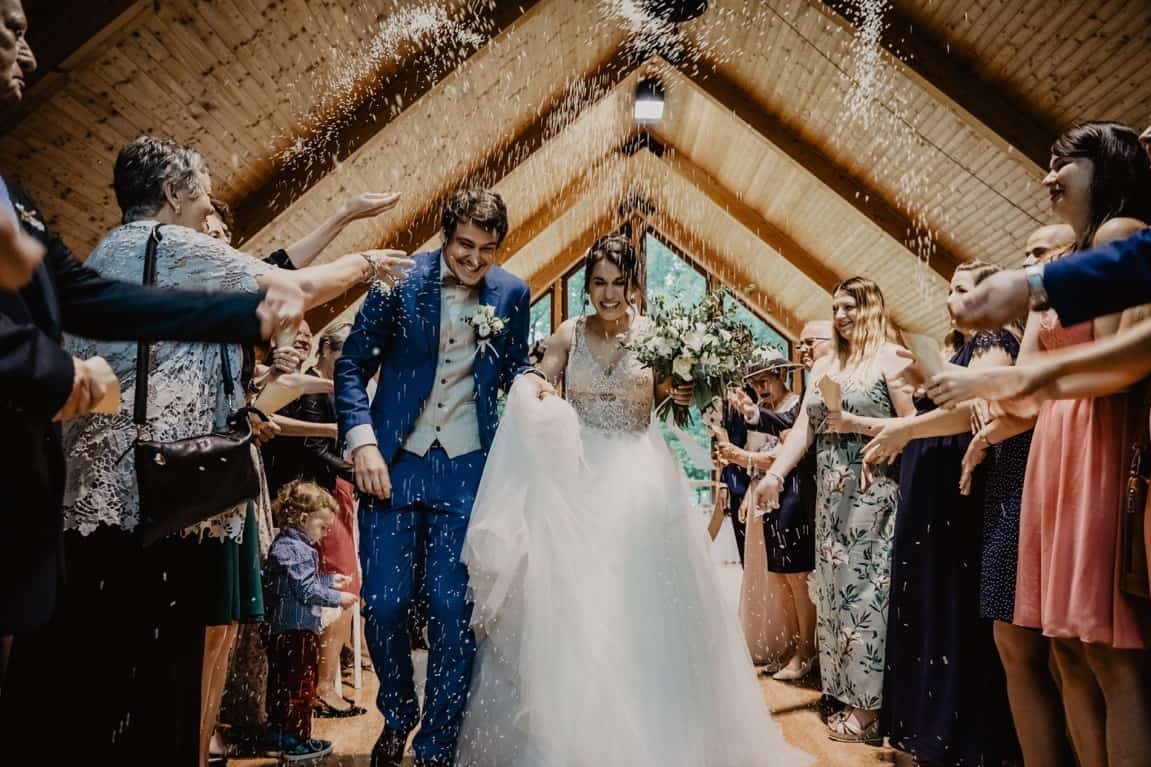Spain, renowned for its exquisite cuisine, iconic tourist destinations, and deep-seated culture, has a rich tapestry of wedding traditions. These customs, rooted in Spain’s vast history of colonization, resonate not only within its borders but also in nations like Mexico, Cuba, Colombia, and Puerto Rico.
Given Spain’s Catholic heritage, many of its wedding traditions are centered around church ceremonies, including wearing a black wedding dress, donning a mantilla, las arras, and the dance of seguidillas manchegas.
Below are 18 memorable Spanish wedding traditions, along with explanations of their symbolism and significance.
Captivating Spanish Wedding Traditions

1. Banquete de Bodas/Convite (Wedding Feast/Reception)
In a Spanish wedding reception, the head table is composed of the newlyweds and their parents. It is common practice for guests to approach the head table so they can give the couple a gift that expresses their gratitude for the invitation. These gifts can either be material or monetary, with the latter often placed inside envelopes.
During the time to eat, the newlyweds or a designated person will make the rounds and give each guest a detalle or wedding favor. Common Spanish wedding favors include
- Cigars
- Pins
- Bottles of wine
- Spanish fans
- Alfajores
- Succulents
- Local art
- Ribbons with the couple’s names and wedding dates written (capias)
As opposed to other Western cultures, speeches are not part of the Spanish wedding traditions. A typical Spanish reception will start with a dinner and then entertainment that lasts all night long.
Seafood is commonly served as the main course in Spanish weddings. Another popular dish is the paella, and couples may choose to prepare other local and regional delicacies. Regardless, guests can expect to eat a five-course meal throughout the night. The cake is typically reminiscent of a flan or a tart and may be full of almonds. Fruits are frequently another dessert option. Guests are usually given sangria and local wines for the beverage.
2. Black Wedding Dress
Although we often associate wedding dresses with the color white and the purity it implies, it is a Spanish wedding tradition for the bride to wear a black, silk dress. Besides its meaning and symbolism, Spanish brides — mostly Catholic — view the black dress as a representation of their lifelong devotion and commitment to their partner; it is a physical embodiment of the phrase “until death do us part.”
It is important to note that this is not required for Spanish brides. However, they may choose to wear a black dress to respect the wedding tradition or to simply add a unique touch to their marriage.
3. Cake-Slicing
4. Cutting the Groom’s Tie
In some Spanish weddings, the groom’s tie will be taken by his friends. Once they have it, they will cut his tie using scissors, then auction off the pieces to the guests. The money earned from this fun Spanish wedding tradition will be used by the newlyweds to fund the next chapter of their life.
5. First Look
Spanish wedding traditions dictate that the groom must not see the bride until their ceremony starts. One of the bride’s father’s responsibilities is to ensure that the bride is not seen by the groom before the wedding.
6. Flowers Galore

The bridal bouquet is usually the responsibility of the padrino or godfather. He will gift it to the bride on her wedding day, typically accompanied by a poem that he wrote or sourced elsewhere. Spanish wedding tradition favors the orange blossom, as its white color represents purity; the flower itself symbolizes happiness and elation for the couple. The flower is also highly fragrant, making it even more appealing to brides.
7. Kids Are Welcome
Whereas couples from other cultures may want to make their reception a no-kids event, it is a Spanish wedding tradition to accommodate children. In fact, your guests might even find it offensive if you explicitly state in the invitation that kids are not invited. Typically, there is a kid’s table filled with activities, toys, and prizes to keep them occupied. Furthermore, some couples even opt to hire entertainers specifically for kids.
8. Las Arras (Gold Coins)
The Spanish wedding tradition of las arras or gold coins involves the groom giving the bride 13 coins during the ceremony. In a Catholic wedding, these coins symbolize Jesus and His 12 apostles. Generally, it represents the groom’s promise to provide and care for his wife during their marriage. Moreover, it also signifies the newlyweds’ wish for good fortune and prosperity.
This wedding tradition can be seen in other Hispanic and Latin wedding traditions, such as Colombian, Puerto Rican, and Costa Rican.
9. Libro de Familia (Family Book)
After the newlyweds’ luna de miel or honeymoon, they will pay a visit to their local register office to present their marriage certificate. Afterward, they will receive a libro de familia or family book, in which the birth of their children will be recorded. Furthermore, this document also acts as a legal certification for the couple’s marriage.
10. Mantilla (Veil)
11. Naming Conventions
Whereas other couples may choose to change surnames or hyphenate after marriage, it is a Spanish wedding tradition for couples to keep their own surnames. The structure of any Spanish name is (First name) (Paternal surname) (Maternal surname). For example, Alma Solaun Espinosa and Miguel Perez Rodríguez, upon marriage, will retain their names.
However, their children will take both of their paternal surnames. In this case, their children’s names would be Patricia Perez Solaun and José Perez Solaun. There are several other naming conventions, but this is the general rule.
12. Padrino System
Similar to other Hispanic and Latin cultures, Spanish weddings usually do not have bridesmaids and groomsmen. Instead, they have padrinos, whose roles are to guide the couple, give them advice, and act as legal witnesses to the marriage. They also escort the couple during the processional. These padrinos are typically the father of the bride and the mother of the groom, though the couple may also choose other close relatives or friends who have known them for a long time.
In a Spanish wedding reception, the padrinos and parents of the newlyweds are honored by setting the head table to have six seats. They will be occupied by the couple and their parents. If the couple already has children prior to entering a marriage, their kids will also sit with them at the head table.
13. Paid Honeymoon

Besides the money garnered from tie-cutting and garter-cutting, newlyweds are also given 15 days of paid “honeymoon leave.” This is also known as “marriage leave” and is prescribed by Spanish law. Couples work with their manager and employer to ensure that they will not get a heavy workload once they return from their leave.
14. Seguidillas Manchegas
The seguidillas manchegas is a Spanish traditional wedding dance similar to el baile del billete of Cuban weddings. To dance with the bride, guests have to pay the bride some amount of money. Sometimes, they may also bid on the garter she is wearing — similar to the groom’s tie mentioned above, the garter will also be cut into pieces. The money gained from these wedding traditions will be used by the newlyweds to create their new home.
15. Start Early, End Early (or Very Late)
While Spanish weddings can begin anytime in the morning or afternoon, Spanish receptions last beyond midnight. Like other Hispanic and Latin cultures, Spanish receptions are filled with entertainment, music, and dancing.
16. Throwing Rice or Rose Petals

In the recessional, as the newlyweds leave the venue, guests will line up outside and throw grains of dried rice or rose petals. As they throw, firecrackers and fireworks may go off in the background. Not only is this an exciting way to start the festivities for the reception, but this is also symbolic of their well-wishes for the couple. Specifically, the rice and rose petals represent good fortune and fertility.
17. Upside Down Pins
The bride usually distributes small pins to the unmarried women in her guest list. They then wear this pin upside down for the duration of the ceremony and reception. The Spanish believe that if they lose this pin anytime during the reception, they will be the next person to get married.
18. Wedding Band and Engagement Ring
The question, “Does the wedding band go on top or under the engagement ring?” is frequently asked by couples worldwide. Spanish couples are spared this confusion, as it is a wedding tradition for the wedding ring to be worn on the ring finger of the right hand. Meanwhile, the engagement ring is worn on the left hand’s ring finger. Stacking rings is not a common practice in Spain.
Final Thoughts
Spain’s wedding customs beautifully showcase its rich history and vibrant culture, each telling a tale of the country’s deep-rooted values and faith. From the striking choice of a black wedding dress to the festive dance of seguidillas manchegas, these traditions epitomize the significance of family and festivity in Spanish life.
Furthermore, the presence of these traditions in different corners of the globe highlights Spain’s lasting cultural legacy. For those who immerse themselves in these customs, whether actively participating or merely observing, they present a distinctive and memorable insight into the essence of Spanish festivities.